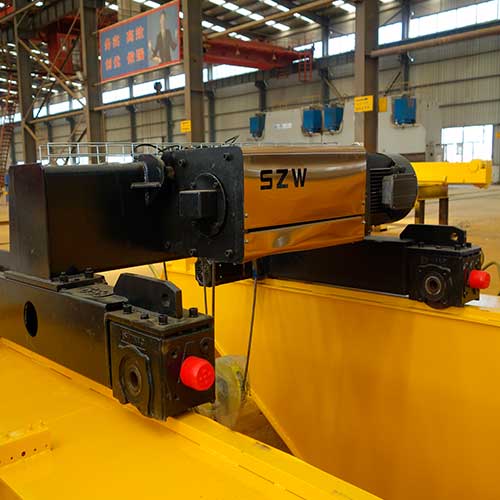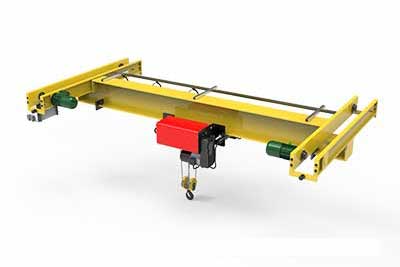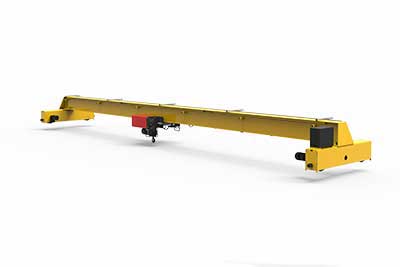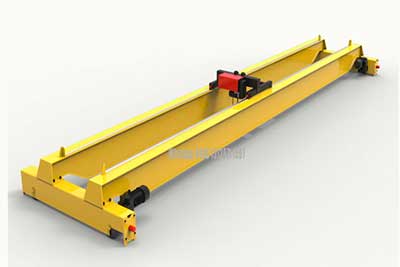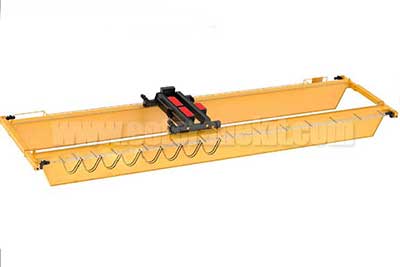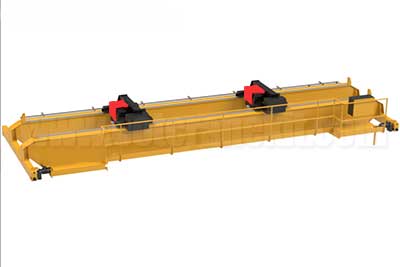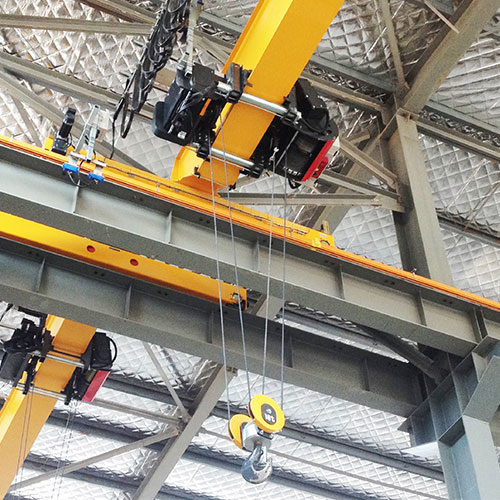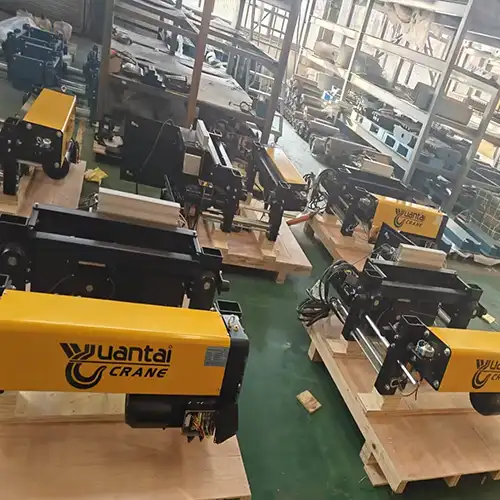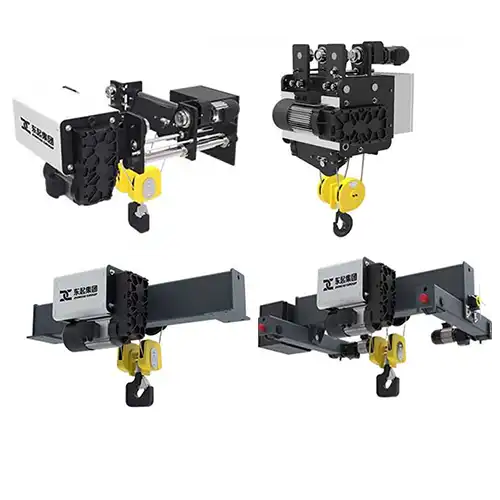Electric Hoists and Bridge Cranes for Ensuring Silent Travelling
Electric hoists & Electric bridge crane for sale. Advanced electric motor, durable bearing, advanced FEM style hoist and crane design, silent travelling.
Category: Featured
Your Trusted Overhead Cranes and Electric Hoists Manufacturer & Supplier
Electric Hoists and Bridge Cranes for Ensuring Silent Travelling, Environment Friendly
Electric hoists & Electric bridge crane for sale. Advanced electric motor, durable bearing, advanced FEM style hoist and crane design, silent travelling.
Electric Hoists and Bridge Cranes for Ensuring Silent Travelling
In today's bustling industrial landscapes, where efficiency and safety are paramount, the concept of silent travelling in electric hoists and cranes has emerged as a critical factor in optimizing operations. The ability to reduce noise while maintaining high performance has become a pivotal consideration for manufacturers and industries worldwide.
Silent travelling within the realm of electric hoists and cranes refers to the operation of these essential lifting and material handling devices with minimal noise emissions. It encapsulates a range of engineering innovations and technologies that focus on reducing operational noise during movement, thereby creating a quieter and more conducive work environment.
The significance of silent operation extends far beyond mere comfort within industrial settings. Excessive noise generated by machinery can adversely impact both the physical and mental wellbeing of workers. Prolonged exposure to high noise levels can lead to stress, fatigue, and even hearing impairment among employees. Furthermore, a noisy environment can hinder communication, compromise safety protocols, and disrupt productivity.
The Significance of Silent Running in Hoists and Cranes
Impact of Noise Pollution on Work Environment and Safety
Noise pollution within industrial workplaces poses a significant threat to the overall work environment and the safety of employees. Electric hoists and cranes, essential for material handling and lifting tasks, are no exception to this concern. The excessive noise generated by these heavyduty machines can lead to various adverse effects on workers.
- Effects on Work Environment: Prolonged exposure to high noise levels can result in increased stress levels and decreased concentration among workers. It can lead to discomfort, irritation, and even headaches, hampering employee morale and overall productivity.
- Safety Implications: Elevated noise levels can mask important audible cues, making it challenging for workers to communicate effectively and hear warning signals or alarms. In environments where precise instructions and communication are crucial for safety, such as construction sites or manufacturing plants, excessive noise can compromise operational safety standards.
Benefits of Quieter Operation in Industrial Settings
Creating a quieter operational environment for electric hoists and cranes yields a multitude of benefits that resonate throughout industrial settings.
- Enhanced Worker Wellbeing: Reduced noise levels contribute to a more pleasant and conducive work atmosphere. It alleviates stress levels and fosters better concentration, positively impacting the mental and physical wellbeing of employees.
- Improved Communication: Quieter operation facilitates clearer communication among workers. It allows for effective exchange of instructions, warnings, and alerts, promoting a safer and more efficient workflow.
- Increased Productivity: A quieter working environment minimizes distractions, allowing employees to focus more effectively on their tasks. This, in turn, enhances productivity and workflow efficiency.
Achieving silent travelling in electric hoists and cranes encompasses an array of factors and technologies. These include advanced engineering designs, precision manufacturing, innovative material selections, and strategic operational methods. In the subsequent sections, we will explore these key factors indepth, unraveling the intricate mechanisms and innovations that contribute to the pursuit of quieter and more efficient hoisting solutions.
Types of Overhead Bridge Cranes for Silent Travelling
Overhead bridge cranes, designed for various lifting requirements, encompass a spectrum of types tailored to distinct operational needs and industries. Understanding the features, benefits, and applications of each type is crucial in selecting the most suitable crane system.
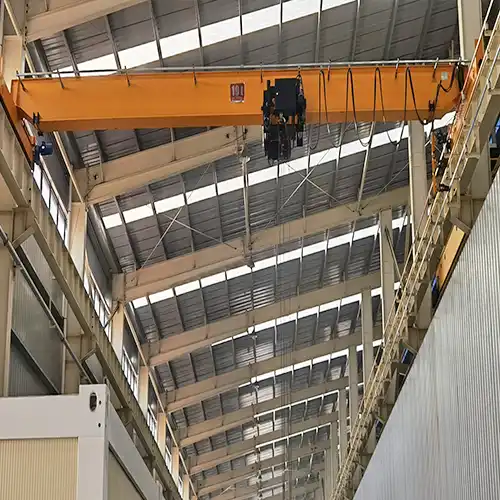
Features: Single girder bridge cranes are characterized by a single beam supporting the hoist and trolley. Their design is ideal for handling lighter loads and operating within smaller spaces.
- Benefits: These cranes offer cost-effectiveness in terms of both installation and maintenance. Their compact design enables easier maneuverability and efficient material handling in constrained environments.
- Applications: Commonly found in small workshops, assembly lines, and maintenance shops, single girder bridge cranes excel in operations requiring precision handling of relatively lighter loads.
- Features: Double girder bridge cranes boast two parallel bridge beams, providing increased stability, higher lifting capacity, and enhanced precision in heavy-duty applications.
- Benefits: The design of double girder cranes allows for handling heavier loads with superior control and stability. They are suitable for industries requiring precision movements and robust lifting capabilities.
Applications: Predominantly used in steel mills, heavy manufacturing plants, and aerospace industries, double girder bridge cranes efficiently manage the demands of large-scale lifting operations.
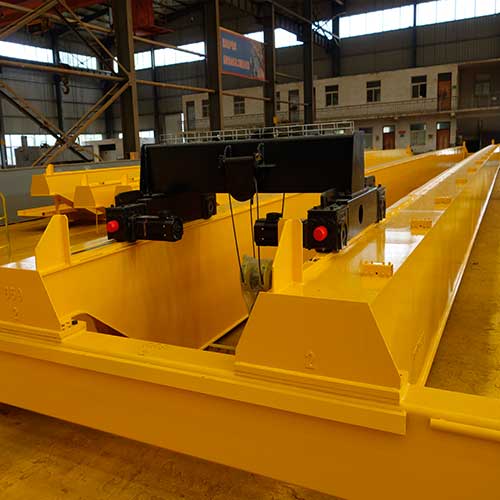
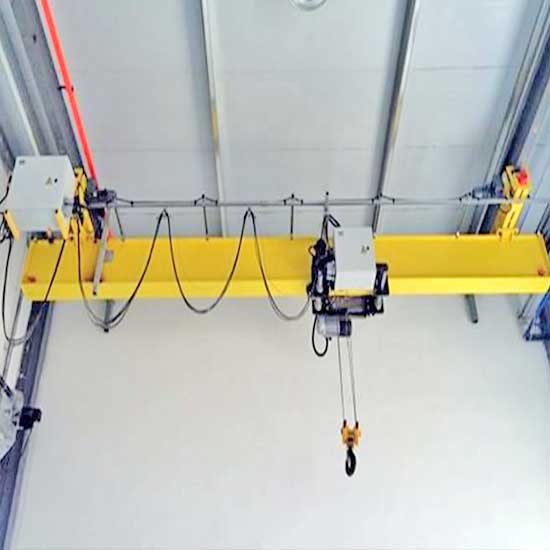
Under Running (Underhung) Bridge Cranes
- Features: Under running bridge cranes run on bottom-mounted rails, making them space-saving solutions. These cranes are well-suited for facilities with limited headroom.
- Benefits: Due to their design, under running bridge cranes optimize space, making them suitable for cleanrooms, smaller manufacturing units, and buildings with low ceilings.
Various Overhead Eot Crane Designs and Configurations
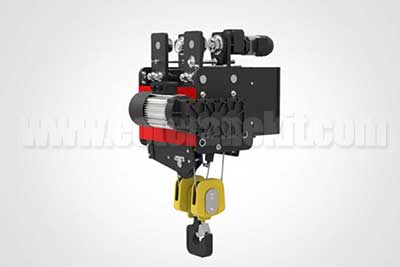
NR mode standard headroom electric hoist
Lifting capacity: 3t~20t
Lifting height: 6m~30m
Work level: M3~M5
Application: For Single Girder Cranes
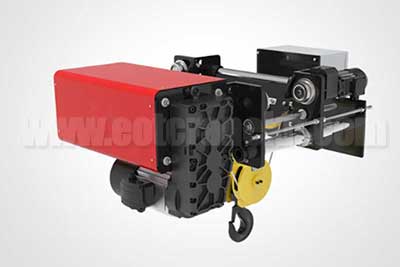
NR mode low headroom electric hoist
Lifting capacity: 3t~20t
Lifting height: 6m~30m
Work level: M3~M5
Application: For Single Girder Cranes
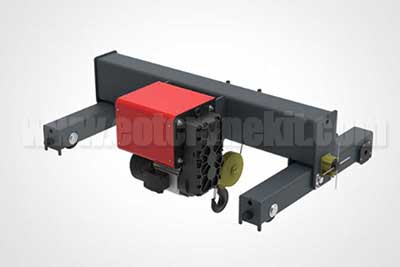
NRT crab electric hoist
Lifting capacity: 3t~80t
Lifting height: 6m~30m
Work level: M3~M5
Application: For Double Girder Cranes
Explosion Proof Electric Wire Rope Hoists

Lifting capacity: 3t~20t
Lifting height: 6m~30m
Work level: M3~M5
Application: For Single Girder Cranes

BNR low headroom explosion-proof electric hoist
Lifting capacity: 3t~20t
Lifting height: 6m~30m
Work level: M3~M5
Application: For Single Girder Cranes

BNRT crab model explosion-proof electric hoist
Lifting capacity: 3t~30t
Lifting height: 6m~30m
Work level: M3~M5
Application: For Double Girder Cranes
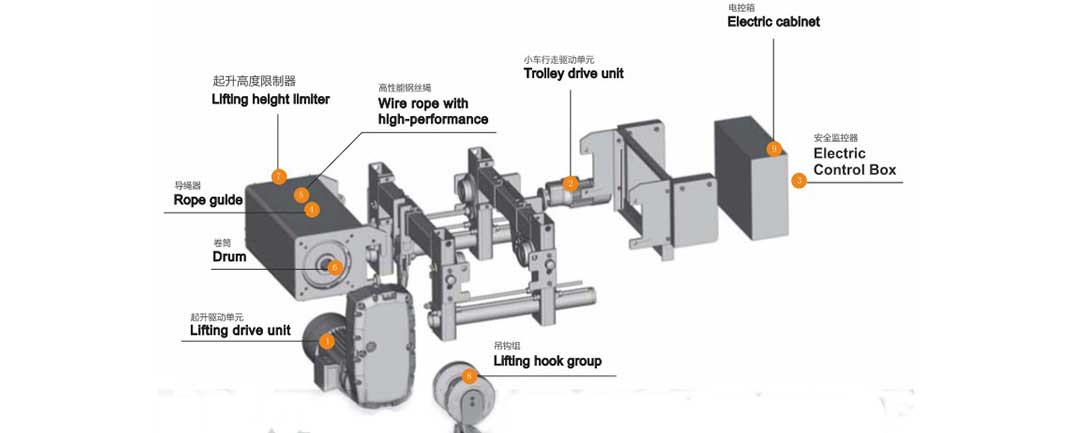
Electromagnetic Design
Utilizing finite element calculations to optimize product structure, electromagnetic noise can be kept within 65dB using highquality silicon steel sheets, with a temperature rise kept below 60°
Bearing Life Calculation
The design life is above 35,000 hours.
Shaft Stress Analysis
Using highstrength alloy steel, with a safety factor above
Ventilation and Heat Dissipation Design
The precise calculation of the casing surface area ensures sufficient heat dissipation. Fan selection involves fluid dynamics simulation to ensure adequate airflow and minimal noise.
Advanced Technologies for Silent Running
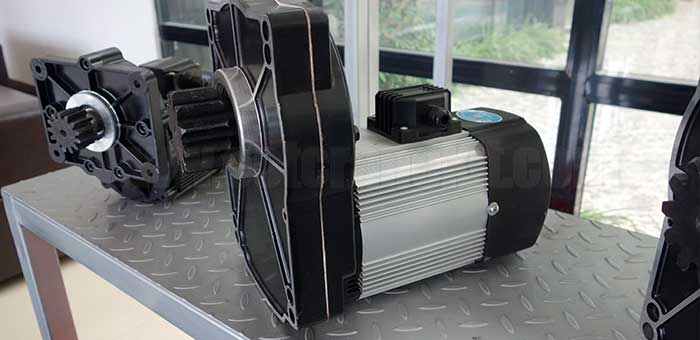
Electromagnetic Design in Driving Motors
The heart of a silent electric hoist or crane lies within its driving motor. The meticulous electromagnetic design incorporated in these motors is a critical aspect in achieving quieter operation. By employing sophisticated finite element calculations, engineers optimize the motor's structure. This process utilizes highquality silicon steel sheets, effectively reducing electromagnetic noise to levels not surpassing 65dMoreover, this meticulous design ensures the management of temperature rise, crucial for maintaining the motor's efficiency and extending its longevity.
Electromagnetic Design in Driving Motors
The driving motor is considered the heart of a silent electric hoist or crane, and achieving quiet operation involves meticulous electromagnetic design. This design process employs advanced techniques, and one key aspect is the use of finite element calculations to optimize the motor's structure. Here are the key points regarding electromagnetic design in driving motors:
Finite Element Calculations:
Engineers utilize sophisticated finite element calculations to model and analyze the electromagnetic properties of the motor.
This advanced computational approach allows for precise optimization of the motor's design, taking into account factors such as magnetic flux distribution, field strength, and electromagnetic interactions.
Optimization of Motor Structure:
The insights gained from finite element calculations are applied to optimize the structure of the driving motor.
Highquality materials, such as silicon steel sheets, are strategically used in the construction of the motor to enhance its electromagnetic properties and performance.
Reduction of Electromagnetic Noise:
A crucial goal of the electromagnetic design is to minimize electromagnetic noise generated during the operation of the crane.
The meticulous design aims to achieve noise levels not surpassing 65dB, ensuring a quiet and unobtrusive operation.
Temperature Management:
The design process also focuses on managing temperature rise within the motor.
Efficient temperature management is crucial for maintaining the motor's overall efficiency and preventing overheating, contributing to the longevity of the motor.
Utilization of Silicon Steel Sheets:
Highquality silicon steel sheets are chosen for their magnetic properties and their ability to reduce energy loss and electromagnetic noise.
These sheets are strategically incorporated into the motor's design to enhance its performance while maintaining a focus on noise reduction.
In summary, the electromagnetic design in driving motors for silent electric hoists and cranes involves a highly detailed and optimized process. Engineers leverage advanced computational tools to finetune the motor's structure, incorporating quality materials and focusing on noise reduction, temperature management, and overall efficiency. The result is a driving motor that operates quietly, efficiently, and with an extended lifespan.
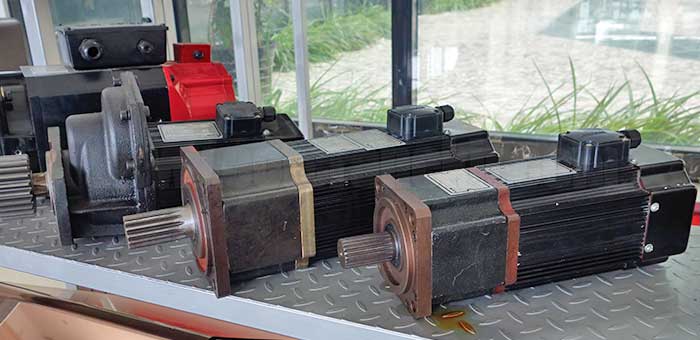
Bearing Life Calculation and Its Impact on Noise Reduction
The design life of bearings within these hoists and cranes surpasses 35,000 operational hours. This extended lifespan not only emphasizes durability but also plays a pivotal role in reducing operational noise. A wellcalculated bearing life contributes to smoother operation, diminishing friction and associated noise levels.
The design of bearings within silent electric hoists and cranes involves meticulous calculations of their life expectancy, and this has a significant impact on noise reduction. Here are the key aspects of bearing life calculation and its role in reducing operational noise:
Extended Bearing Life:
The design philosophy focuses on achieving a remarkable bearing life that surpasses 35,000 operational hours.
This extended lifespan is a testament to the durability and robustness of the bearings used in these hoists and cranes.
Durability Emphasis:
The emphasis on an extended bearing life goes beyond noise reduction; it underscores the overall durability and reliability of the bearings.
Bearings designed to last for an extended period contribute to the longevity and efficiency of the entire hoist or crane system.
Operational Noise Reduction:
The prolonged bearing life plays a pivotal role in reducing operational noise during the crane's movement.
As bearings wear out over time, they can contribute to increased friction and noise. By designing bearings with an extended life, the frequency of maintenance and potential noise sources are minimized.
Smoother Operation:
Calculating and optimizing bearing life contributes to smoother operation of the hoist or crane.
A wellcalculated bearing life ensures that the bearings operate within their designed parameters, minimizing friction and associated noise levels.
Diminishing Friction and Noise:
The design considerations aim to diminish friction within the bearings, directly impacting noise levels during crane operation.
The reduction in friction leads to quieter movement, enhancing the overall user experience and minimizing disruptions in the surrounding environment.
In summary, the emphasis on bearing life calculation in silent electric hoists and cranes extends beyond durability, with a direct impact on noise reduction. The goal is to achieve an extended lifespan for bearings, ensuring smoother operation, diminishing friction, and ultimately reducing operational noise levels. This approach aligns with the broader objective of creating efficient, reliable, and unobtrusive crane systems.
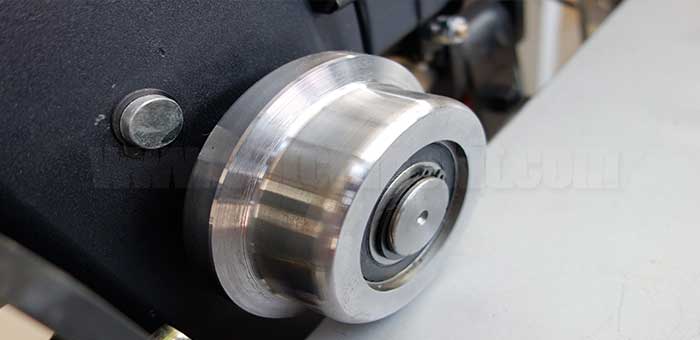
Shaft Stress Analysis and Its Contribution to Silent Operation
The motor shaft, crafted from highstrength alloy steel, undergoes rigorous stress analysis. This material's robustness, coupled with a safety factor exceeding 5, ensures the shaft can withstand operational stresses without compromising safety or performance. This meticulous analysis contributes significantly to the overall silent operation of the hoist or crane.
The motor shaft in silent electric hoists and cranes is a critical component, and its silent operation is achieved through a meticulous stress analysis. Here are the key aspects of shaft stress analysis and its contribution to silent operation:
High Strength Alloy Steel Construction:
The motor shaft is crafted from highstrength alloy steel, emphasizing the importance of using materials known for their durability and resilience.
Highstrength alloy steel provides the necessary structural integrity to withstand operational stresses.
Rigorous Stress Analysis:
The motor shaft undergoes a rigorous stress analysis process to evaluate its ability to withstand various operational loads and conditions.
This analysis involves advanced engineering techniques to simulate and assess the impact of forces, torques, and dynamic loads on the shaft.
Robustness of Material:
The robustness of the highstrength alloy steel ensures that the motor shaft can endure significant stresses without experiencing deformation or failure.
The goal is to design a shaft that maintains its structural integrity over time, contributing to the longevity and reliability of the entire hoist or crane system.
Safety Factor Exceeding 5:
The shaft's design incorporates a safety factor that exceeds 5, indicating a significant margin of safety beyond the calculated operational stresses.
This safety factor ensures that the shaft can handle unexpected or fluctuating loads without compromising safety or performance.
Contribution to Silent Operation:
The meticulous stress analysis of the motor shaft plays a crucial role in achieving silent operation of the hoist or crane.
By ensuring that the shaft is structurally sound and capable of withstanding operational stresses, the analysis contributes to minimizing vibrations and noise during crane movement.
In summary, the silent operation of the hoist or crane is intricately tied to the design and analysis of the motor shaft. The use of highstrength alloy steel, coupled with a rigorous stress analysis and a safety factor exceeding 5, ensures that the shaft can withstand operational stresses while contributing significantly to the overall goal of silent and efficient crane operation.
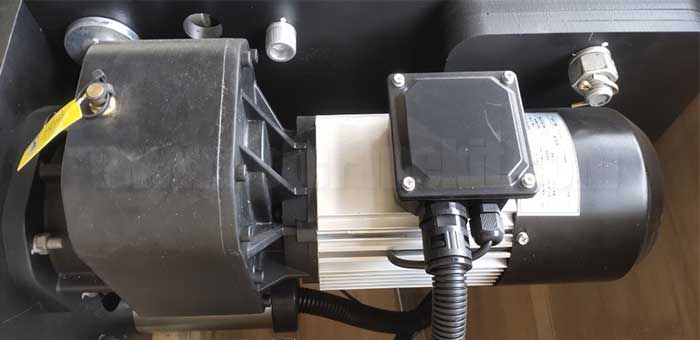
Ventilation and Heat Dissipation Designs for Noise Control
Precise calculations determine the motor housing's design, facilitating efficient heat dissipation. This critical feature helps maintain the motor's temperature within optimal ranges, ensuring sustained performance and extended lifespan. Additionally, fan selection involves fluid dynamics simulation, guaranteeing adequate airflow for effective cooling. This strategic design not only controls temperature but also minimizes noise levels, providing a quieter operational environment.
The design of ventilation and heat dissipation systems in silent electric hoists and cranes is a critical aspect of noise control. This involves precise calculations to determine the motor housing's design and strategic features to facilitate efficient heat dissipation. Here are the key components of ventilation and heat dissipation designs for noise control:
Motor Housing Design:
Precise calculations are employed to determine the design of the motor housing, taking into account factors such as size, shape, and material properties.
The goal is to create a housing that promotes efficient heat dissipation while maintaining structural integrity.
Efficient Heat Dissipation:
The design of the motor housing is tailored to facilitate efficient heat dissipation from the internal components, particularly the driving motor.
Effective heat dissipation is crucial for maintaining the motor's temperature within optimal ranges, ensuring sustained performance and an extended lifespan.
Temperature Control:
The ventilation and heat dissipation designs contribute to precise temperature control within the motor housing.
Maintaining optimal temperature levels is essential for preventing overheating and ensuring the motor operates at peak efficiency.
Fan Selection with Fluid Dynamics Simulation:
The selection of fans for the ventilation system involves fluid dynamics simulation.
This advanced simulation helps engineers choose fans that provide adequate airflow for effective cooling, considering factors such as fan blade design and rotation speed.
Noise Minimization:
The strategic design of ventilation and heat dissipation systems goes beyond temperature control; it also aims to minimize noise levels during crane operation.
By optimizing the airflow and fan selection, the design contributes to a quieter operational environment, aligning with the overall goal of silent electric hoists and cranes.
Quieter Operational Environment:
The combined effect of efficient heat dissipation and noiseminimizing designs creates a quieter operational environment for the hoist or crane.
This feature is particularly important in environments where noise reduction is a priority, such as manufacturing facilities or indoor spaces.
In summary, the meticulous design of ventilation and heat dissipation systems in silent electric hoists and cranes involves precise calculations and strategic features. By focusing on efficient heat dissipation, temperature control, fan selection with fluid dynamics simulation, and noise minimization, engineers achieve a holistic approach to creating a quieter and more efficient operational environment for these cranes.
These advanced technologies integrated into the driving motors of electric hoists and cranes underscore a commitment to achieving silent running. Each component's intricate engineering and design contribute to a harmonious balance between efficiency, durability, and reduced operational noise, aligning with the pursuit of quieter industrial environments.
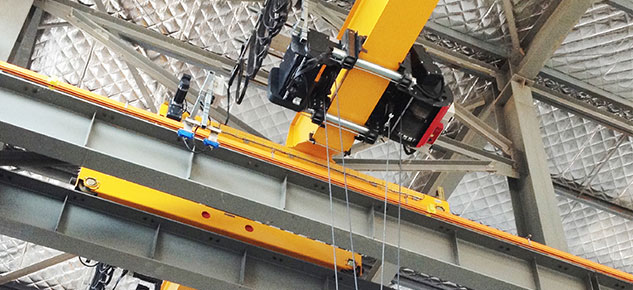
Modular End Carriage
Flexible Design , Easy Assembly, Wide Applications
The various combinations of 2 wheels,4 wheels,8 wheels, and 16 wheels will be satisfied withdifferent wheel pressure.
The various combinations of end carriage and main girder are easily adapted to different workshop space.
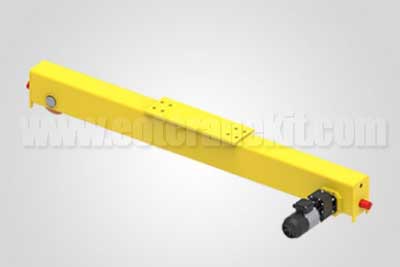
Top running single girder crane end carriage
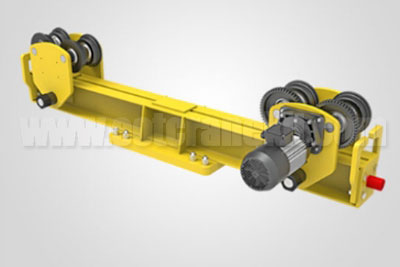
Underhung single girder crane end carriage
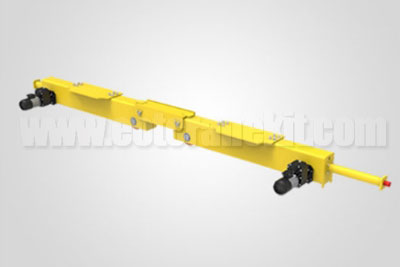
Top running double girder crane end carriage

Gear Motor
Silent technology ,enjoy handling.We lead the way of drive for cranes.
You will enjoy silent handling with our new technology of drive.We advocate energy saving with our new technology of drive.
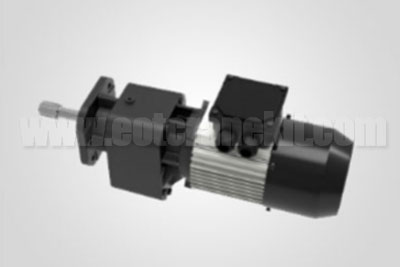
Electric motor
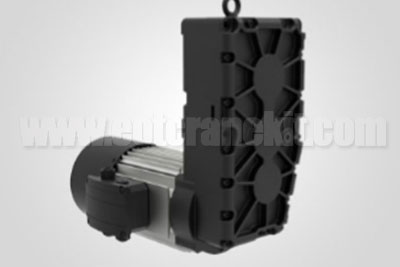
3-in-1 electric motor
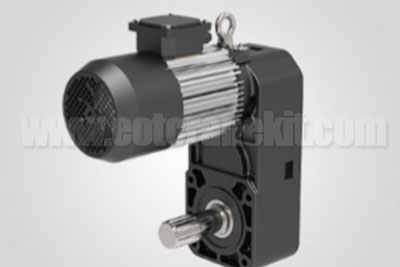
Driven electric hoist
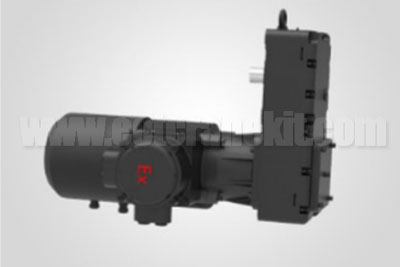
Explosion proof motor
Modular Overhead Crane Wheels, Rope Guide and Pulley
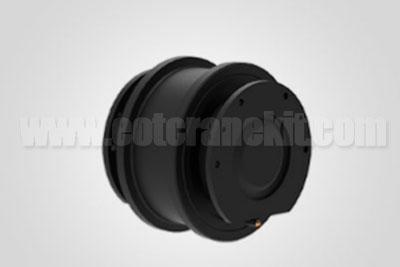
crane wheel group

driven wheel
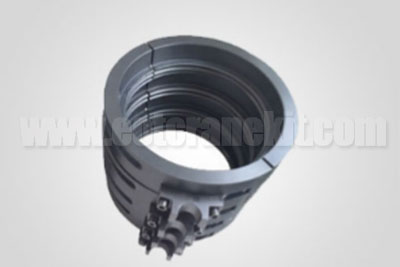
wire rope guide
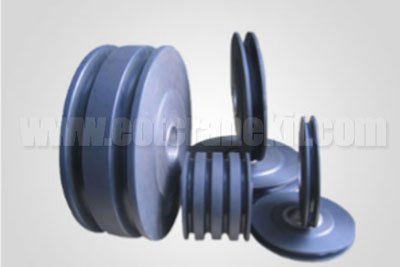
Pulley
Modular Overhead Crane Electrical Panel

electrical panel

electrical panel
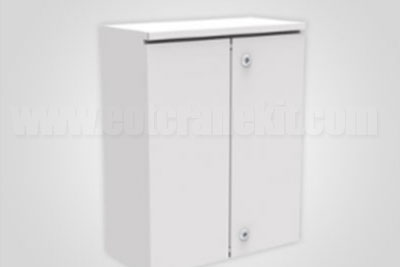
electrical panel

electrical panel
Control Systems and Automation in Modular Cranes
Control systems form the brains of modular cranes, integrating advanced technology for efficient operation, safety, and monitoring.
Details on Advanced Technology Integration:
- Safety Features: Incorporation of sensors, limit switches, and emergency stop mechanisms ensures safe crane operation, preventing accidents and damage.
- Monitoring Systems: Advanced control systems offer real-time monitoring of load capacity, position, and crane health, enhancing operational efficiency and safety.
Efficiency through Automation:
Automation in modular crane systems streamlines operations, allowing for precision movements, automated load positioning, and reduced manual intervention, thereby optimizing overall efficiency.
These core components of modular crane systems is crucial for assessing their capabilities, functionalities, and suitability for specific industrial applications.
Structural Elements and Material Innovations

Drive Mechanisms and Motor Power Variations
Drive mechanisms are pivotal components influencing the silent operation of electric hoists and cranes. The availability of diverse drive mechanisms, compatible with various motor power options, offers flexibility in customizing these machines based on specific operational needs and load capacities. This compatibility ensures an optimal match between the drive mechanism and motor power, contributing to quieter and more efficient performance.
Drive mechanisms play a pivotal role in influencing the silent operation of electric hoists and cranes. The availability of diverse drive mechanisms, coupled with variations in motor power, offers a high degree of flexibility for customizing these machines based on specific operational needs and load capacities. Here are the key components of drive mechanisms and motor power variations:
Pivotal Role of Drive Mechanisms:
Drive mechanisms are critical components that directly impact the operation and performance of electric hoists and cranes.
The selection of an appropriate drive mechanism is essential for achieving not only efficient but also silent crane operation.
Diverse Drive Mechanisms:
The design incorporates diverse drive mechanisms, providing a range of options for different applications.
Common drive mechanisms include electric chain hoists, wire rope hoists, and various configurations of trolley systems. Each mechanism has its advantages and is selected based on specific use cases and requirements.
Compatibility with Motor Power Options:
The drive mechanisms are designed to be compatible with various motor power options.
This compatibility allows for the customization of electric hoists and cranes based on specific operational needs, load capacities, and environmental conditions.
Flexibility in Customization:
The availability of different drive mechanisms and motor power variations offers flexibility in customizing these machines.
Users can tailor the equipment to meet the demands of their specific industry, applications, and lifting requirements.
Optimal Match Between Mechanism and Motor Power:
A key consideration in the design is ensuring an optimal match between the selected drive mechanism and the motor power.
This alignment is crucial for achieving not only efficient but also quieter crane performance. The coordination ensures that the motor operates within its designed parameters, minimizing unnecessary noise.
Contribution to Quieter and Efficient Performance:
The careful selection of drive mechanisms and their compatibility with motor power variations contributes significantly to achieving quieter and more efficient crane performance.
This integrated approach ensures that the components work harmoniously, reducing friction, vibrations, and noise during crane operation.
In summary, the design philosophy of incorporating diverse drive mechanisms and motor power variations is centered around providing flexibility and customization. This ensures that electric hoists and cranes can be tailored to meet specific operational needs while maintaining optimal performance, efficiency, and silent operation. The careful coordination between drive mechanisms and motor power variations enhances the overall user experience and operational effectiveness of these machines.
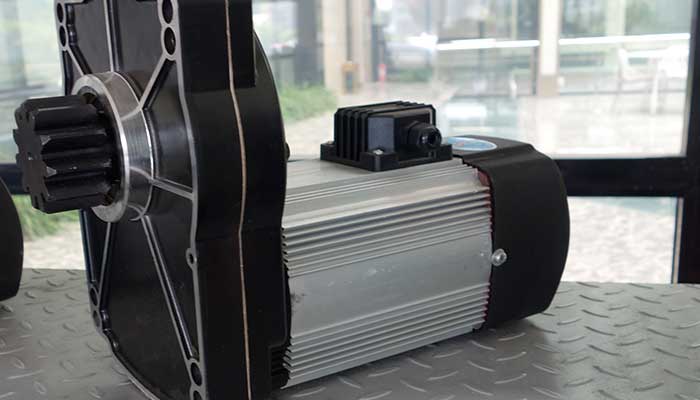
Lightweight Alloy Casings: Importance and Advantages
The use of lightweight alloy casings serves as a fundamental element in the design of electric hoists and cranes. These casings maintain structural integrity while reducing overall weight, facilitating easier handling and installation. The advantages extend to enhancing mobility and installation flexibility without compromising the robustness required for heavyduty industrial applications.
The incorporation of lightweight alloy casings is a fundamental element in the design of electric hoists and cranes. These casings play a crucial role in maintaining structural integrity while offering several advantages that contribute to the overall efficiency and flexibility of these machines. Here are the key points regarding the importance and advantages of lightweight alloy casings:
Fundamental Design Element:
Lightweight alloy casings are a foundational aspect of the design philosophy for electric hoists and cranes.
The choice of lightweight alloys as casing materials reflects a strategic decision to balance structural strength with reduced overall weight.
Maintaining Structural Integrity:
Despite being lightweight, alloy casings are designed to maintain high structural integrity.
The materials selected for these casings are chosen for their strength and durability, ensuring that the casings can withstand the rigors of heavyduty industrial applications.
Weight Reduction for Easier Handling:
The use of lightweight alloy casings contributes to an overall reduction in the weight of the electric hoists and cranes.
This weight reduction facilitates easier handling during installation, maintenance, and other operational tasks.
Facilitating Installation:
The reduced overall weight of the hoists and cranes with lightweight alloy casings facilitates easier installation.
This is particularly advantageous in scenarios where quick and flexible installation is required, providing operational efficiency.
Enhancing Mobility:
The lightweight nature of the alloy casings enhances the mobility of electric hoists and cranes.
Mobility is crucial in applications where the equipment needs to be moved or repositioned frequently.
Installation Flexibility:
The advantages of lightweight alloy casings extend to installation flexibility.
These casings enable a more versatile and adaptable approach to installing hoists and cranes in diverse industrial settings.
No Compromise on Robustness:
Despite being lightweight, the alloy casings do not compromise on the robustness required for heavyduty industrial applications.
The materials are carefully selected to ensure that the casings maintain durability and toughness in demanding operational environments.
In summary, the use of lightweight alloy casings is a strategic design choice that offers a balance between structural integrity and reduced overall weight. The advantages include easier handling, enhanced mobility, installation flexibility, and the ability to maintain robustness for heavyduty applications. This design approach contributes to the overall efficiency and effectiveness of electric hoists and cranes in various industrial settings.

Low Carbon Alloy Forged Steel: Precision and Noise Reduction
Lowcarbon alloy forged steel, particularly in crucial components like gears, plays a pivotal role in achieving precision and noise reduction. The precisionengineered gear mechanisms, reaching a high level of accuracy rated at level 6, ensure smooth and efficient operation. This precision minimizes noise generation, providing a quieter operational environment.
The use of lowcarbon alloy forged steel, especially in critical components like gears, is a pivotal element in achieving precision and noise reduction in the design of electric hoists and cranes. Here are the key aspects of the role played by lowcarbon alloy forged steel in precision and noise reduction:
Critical Role in Gears:
Lowcarbon alloy forged steel is strategically employed in crucial components, particularly gears.
Gears are essential for the transmission of power within the hoists and cranes, and the choice of lowcarbon alloy forged steel ensures the necessary strength and durability.
PrecisionEngineered Gear Mechanisms:
The gears, crafted from lowcarbon alloy forged steel, are precisionengineered to reach a high level of accuracy rated at level
Precision is a critical factor in the design of gear mechanisms, and achieving a high level of accuracy ensures smooth and efficient operation.
Smooth and Efficient Operation:
The precisionengineered gear mechanisms contribute to the overall smooth and efficient operation of the hoists and cranes.
Smooth operation is essential for minimizing vibrations and disturbances, ultimately reducing noise during crane movement.
Minimization of Noise Generation:
The precision achieved in gear mechanisms plays a crucial role in minimizing noise generation during crane operation.
The finely crafted gears reduce friction and ensure that the transmission of power is conducted with minimal noise, contributing to a quieter operational environment.
Quieter Operational Environment:
The combination of precisionengineered gear mechanisms and lowcarbon alloy forged steel contributes to creating a quieter operational environment.
This is particularly significant in industrial settings where noise reduction is a priority for the comfort of workers and compliance with noise regulations.
Durability and Toughness:
Lowcarbon alloy forged steel is selected not only for precision but also for its durability and toughness.
The material ensures that gears withstand the rigors of heavyduty applications, maintaining performance over an extended lifespan.
In summary, the use of lowcarbon alloy forged steel in critical components like gears is instrumental in achieving precision and noise reduction in electric hoists and cranes. Precisionengineered gear mechanisms crafted from this material contribute to smooth and efficient operation, while the reduction of noise generation enhances the overall quality of the operational environment. The durability and toughness of lowcarbon alloy forged steel further ensure the reliability of gear components in demanding industrial applications.
HighQuality Seals and Industrial Gear Oil for Quieter Operation
The integration of highquality seals within the hoist or crane serves as a barrier against contaminants, ensuring protection from dust, moisture, and environmental factors. Paired with industrialgrade gear oil, these seals contribute to enhanced lubrication and reduced friction within the system, promoting smoother and quieter operation.
HighQuality Seals and Industrial Gear Oil for Quieter Operation
The integration of highquality seals and the use of industrialgrade gear oil within electric hoists and cranes are key factors contributing to quieter operation. These components work in tandem to provide protection against contaminants, ensure effective lubrication, and reduce friction within the system. Here are the key aspects of the role played by highquality seals and industrial gear oil in achieving quieter operation:
Protection Against Contaminants:
Highquality seals are strategically integrated into the hoist or crane to act as barriers against contaminants such as dust, moisture, and other environmental factors.
These seals provide a protective layer, preventing contaminants from entering critical components and affecting the performance of the system.
Barrier Against Dust and Moisture:
The seals act as an effective barrier, particularly against dust and moisture, which can be detrimental to the internal components of the hoist or crane.
Protection against environmental factors ensures the longevity and reliability of the system.
Enhanced Lubrication:
The combination of highquality seals and industrialgrade gear oil contributes to enhanced lubrication of moving parts.
The seals help retain the gear oil within the system, ensuring that the critical components are adequately lubricated for smooth operation.
Reduced Friction:
Industrialgrade gear oil is chosen for its properties that reduce friction between moving parts.
The effective lubrication provided by the gear oil, in combination with highquality seals, minimizes friction within the system, promoting smoother and quieter operation.
Promoting Smoother Operation:
The integrated system of highquality seals and industrial gear oil collectively promotes smoother operation of the hoist or crane.
Smoother operation is crucial for minimizing vibrations and disturbances, contributing to a quieter overall performance.
Quieter Operational Environment:
The combined effect of highquality seals and industrial gear oil is a quieter operational environment for the electric hoist or crane.
Reduced friction and effective lubrication contribute to noise reduction during crane movement, enhancing the user experience and minimizing disruptions in the surrounding environment.
Maintenance of System Efficiency:
The protective role of seals and the lubricating properties of industrialgrade gear oil contribute to maintaining the efficiency of the system over time.
Proper maintenance ensures that the hoist or crane operates quietly and reliably throughout its lifespan.
In summary, the integration of highquality seals and the use of industrialgrade gear oil are integral to achieving quieter operation in electric hoists and cranes. These components provide protection against contaminants, enhance lubrication, reduce friction, and collectively contribute to creating a quieter and more efficient operational environment. The combination of these features ensures the reliability and longevity of the hoist or crane system in various industrial applications.
The strategic implementation of these structural elements and material innovations underscores the commitment to achieving silent operation in electric hoists and cranes. Each component's design and material selection contribute synergistically towards creating quieter and more efficient industrial solutions.
Silent Travelling Techniques and Engineering
Gear Design: Friction Reduction and Noise Minimization
The gear system in electric hoists and cranes is engineered to minimize both friction and noise during movement. Highquality gears, often crafted from durable materials and precisionmachined, play a pivotal role in ensuring smooth operation. Carefully designed gear configurations aim to minimize meshing noise, contributing significantly to a quieter operational environment.
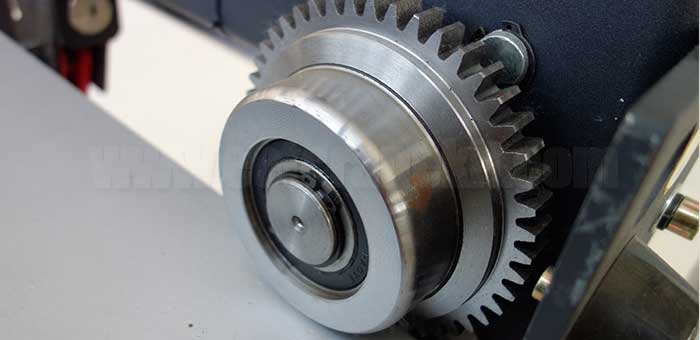
Gear Design: Friction Reduction and Noise Minimization
The gear system in electric hoists and cranes is meticulously engineered to achieve dual objectives—minimizing both friction and noise during movement. Highquality gears, often crafted from durable materials and precisionmachined, play a pivotal role in ensuring smooth operation. Here are the key aspects of gear design focused on friction reduction and noise minimization:
HighQuality Gear Materials:
The gears within the electric hoists and cranes are crafted from highquality and durable materials.
The selection of materials is crucial for ensuring the strength and longevity of the gears, contributing to reliable and longlasting performance.
Precision Machining:
Gears undergo precision machining processes to achieve exacting tolerances and smooth surfaces.
Precision machining ensures that the gears mesh seamlessly, reducing friction and minimizing noise during operation.
Durable Construction:
The durability of the gear system is emphasized in the design to withstand the demanding conditions of industrial applications.
Durable construction enhances the overall reliability of the electric hoist or crane system.
Smooth Operation:
Highquality gears, combined with precision machining, contribute to smooth gear engagement and disengagement during operation.
Smooth operation is essential for minimizing vibrations and disturbances, resulting in a quieter overall performance.
Carefully Designed Gear Configurations:
The gear configurations are carefully designed to minimize meshing noise.
The arrangement and design of gears aim to reduce the impact and friction during meshing, thereby contributing significantly to noise reduction.
Minimization of Meshing Noise:
Meshing noise, which can be a source of operational noise in gear systems, is targeted for minimization in the design.
Through careful engineering, the gear system aims to minimize meshing noise during the movement of the electric hoist or crane.
Quiet Operational Environment:
The collective result of highquality gears, precision machining, and carefully designed configurations is a gear system that contributes to a quieter operational environment.
The focus on noise minimization ensures that the electric hoist or crane operates with reduced disturbances, promoting a more comfortable workplace environment.
Contributing to Overall System Efficiency:
The gear design not only focuses on noise reduction but also plays a crucial role in maintaining the overall efficiency of the electric hoist or crane system.
Efficient gear systems contribute to energy savings, reduced wear and tear, and prolonged system lifespan.
In summary, the gear design in electric hoists and cranes is a comprehensive approach aimed at minimizing both friction and noise during movement. Highquality materials, precision machining, and carefully designed configurations collectively contribute to creating a gear system that operates smoothly, quietly, and efficiently, meeting the demands of various industrial applications.
Advanced Motor Technology for Controlled Operation
Utilizing cuttingedge motor technology, such as frequencycontrolled drives or variable frequency drives (VFDs), enables precise control over speed and acceleration. This technology ensures smoother startups, accelerations, and decelerations, reducing abrupt movements and associated noise during operation.
In the design of electric hoists and cranes, advanced motor technology plays a crucial role in achieving controlled and precise operation. This often involves the utilization of cuttingedge motor technologies, such as frequencycontrolled drives or variable frequency drives (VFDs). The implementation of these technologies allows for precise control over speed and acceleration, ensuring smoother startups, accelerations, and decelerations. This, in turn, reduces abrupt movements and associated noise during operation. Here are the key aspects of advanced motor technology for controlled operation:
FrequencyControlled Drives or VFDs:
Cuttingedge motor technologies often include the use of frequencycontrolled drives or variable frequency drives (VFDs).
These technologies enable dynamic control over the frequency of electrical power supplied to the motor, allowing for precise adjustments to speed and acceleration.
Precise Control Over Speed and Acceleration:
The key advantage of advanced motor technology is the ability to achieve precise control over the speed and acceleration of the electric hoist or crane.
Operators can finetune these parameters, ensuring that movements are controlled, gradual, and free from sudden jolts.
Smoother StartUps and Decelerations:
Advanced motor technology contributes to smoother startups and decelerations.
The controlled application of power to the motor ensures that the hoist or crane starts and stops gradually, minimizing sudden movements that could generate noise.
Reduction of Abrupt Movements:
The implementation of frequencycontrolled drives or VFDs significantly reduces abrupt movements during crane operation.
The controlled acceleration and deceleration contribute to a more stable and controlled movement, reducing the potential for noise generation.
Noise Reduction during Operation:
The controlled and precise operation facilitated by advanced motor technology leads to noise reduction.
By eliminating sudden and erratic movements, the technology contributes to a quieter operational environment, enhancing the user experience.
Enhanced Operator Experience:
Operators benefit from the advanced motor technology as it provides them with better control and responsiveness.
The technology enhances the overall experience for operators, allowing for more accurate positioning and efficient load handling.
Energy Efficiency:
Advanced motor technologies often come with energyefficient features, contributing to overall energy savings.
The controlled operation not only reduces noise but also enhances the energy efficiency of the electric hoist or crane system.
In summary, the integration of advanced motor technology, such as frequencycontrolled drives or VFDs, is a key aspect of achieving controlled and precise operation in electric hoists and cranes. This technology allows for dynamic adjustments to speed and acceleration, leading to smoother startups, decelerations, and reduced abrupt movements. The result is a quieter operational environment, improved operator experience, and enhanced energy efficiency in various industrial applications.
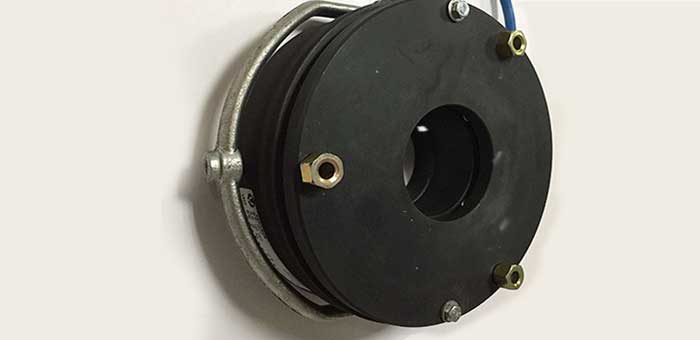
Braking Systems and Controlled Stops for Noise Reduction
Efficient and sophisticated braking systems are instrumental in ensuring controlled stops, preventing sudden jolts or noise when the hoist or crane comes to a halt. These braking mechanisms contribute to a smoother deceleration process, minimizing noise generation.
Efficient and sophisticated braking systems play a crucial role in the design of electric hoists and cranes, contributing to controlled stops and noise reduction. These braking mechanisms are instrumental in preventing sudden jolts or noise when the hoist or crane comes to a halt. Here are the key aspects of braking systems and controlled stops for noise reduction:
Efficient Braking Systems:
The design incorporates efficient braking systems that are capable of providing precise and controlled stops.
These braking systems are crucial for the safe and controlled operation of the hoist or crane.
Braking Systems and Controlled Stops for Noise Reduction
Efficient and sophisticated braking systems are instrumental in ensuring controlled stops, preventing sudden jolts or noise when the hoist or crane comes to a halt. These braking mechanisms contribute to a smoother deceleration process, minimizing noise generation.
Efficient and sophisticated braking systems play a crucial role in the design of electric hoists and cranes, contributing to controlled stops and noise reduction. These braking mechanisms are instrumental in preventing sudden jolts or noise when the hoist or crane comes to a halt. Here are the key aspects of braking systems and controlled stops for noise reduction:
Efficient Braking Systems:
The design incorporates efficient braking systems that are capable of providing precise and controlled stops.
These braking systems are crucial for the safe and controlled operation of the hoist or crane.
Instrumental for Controlled Stops:
Braking systems are instrumental in ensuring controlled stops, preventing abrupt or sudden halts.
The controlled stops contribute to a more stable and controlled deceleration process, reducing the likelihood of noise generation.
Preventing Sudden Jolts:
The braking mechanisms are designed to prevent sudden jolts or shocks when the hoist or crane comes to a stop.
Sudden stops can lead to vibrations and noise, which are effectively minimized through the use of sophisticated braking systems.
Smooth Deceleration Process:
The braking systems contribute to a smoother deceleration process during the stopping phase.
The controlled application of brakes ensures that the hoist or crane slows down gradually, further reducing noise generation.
Minimizing Noise Generation:
A key objective of incorporating efficient braking systems is to minimize noise generation during stops.
The controlled stops, coupled with the braking mechanisms, contribute significantly to creating a quieter operational environment.
Enhanced Safety:
Efficient braking systems enhance the safety of the hoist or crane operation.
Controlled stops not only contribute to noise reduction but also ensure that the equipment comes to a halt in a safe and controlled manner.
Operator Comfort:
The use of braking systems that provide controlled stops enhances the comfort of operators.
Operators can rely on the braking mechanisms to bring the hoist or crane to a stop smoothly and predictably, contributing to a positive operator experience.
Maintenance of Equipment Integrity:
Controlled stops, facilitated by efficient braking systems, contribute to maintaining the integrity of the hoist or crane equipment.
Sudden stops can impose stress on components, leading to wear and tear. Controlled stops help extend the lifespan of the equipment.
In summary, the incorporation of efficient and sophisticated braking systems is pivotal for achieving controlled stops and noise reduction in electric hoists and cranes. These braking mechanisms ensure that the deceleration process is smooth, preventing sudden jolts and minimizing noise generation during operation. The focus on controlled stops enhances safety, operator comfort, and the overall integrity of the equipment in various industrial applications.
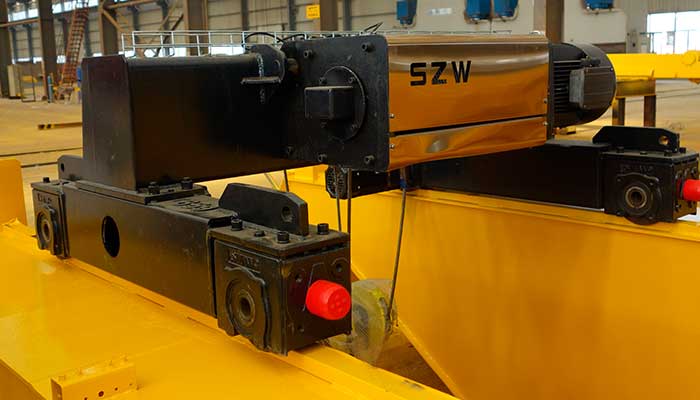
Wheel and Rail Design for Vibration and Noise Reduction
In systems utilizing wheels and rails, precisionengineered designs of these components are crucial. Highquality materials and meticulous engineering aim to reduce vibrations and noise during movement. Optimal design and alignment help minimize operational noise, creating a quieter travelling experience.
In systems utilizing wheels and rails, the precision engineering of these components is crucial for achieving vibration and noise reduction. The design incorporates highquality materials and meticulous engineering to minimize vibrations and noise during movement. Optimal design and alignment of wheels and rails contribute to the overall reduction of operational noise, creating a quieter traveling experience. Here are the key aspects of wheel and rail design focused on vibration and noise reduction:
PrecisionEngineered Designs:
Wheels and rails are precisionengineered with meticulous attention to detail.
The design process focuses on achieving exacting tolerances and smooth surfaces to minimize friction and vibrations.
High Quality Materials:
High quality materials are used in the construction of wheels and rails.
The selection of materials is crucial for durability, wear resistance, and the ability to dampen vibrations, contributing to a quieter operational experience.
Meticulous Engineering:
The engineering of wheels and rails involves precision calculations and testing to ensure optimal performance.
Meticulous engineering is essential for achieving the desired level of vibration and noise reduction during the movement of the hoist or crane.
Reducing Vibrations during Movement:
The design of wheels and rails aims to reduce vibrations generated during movement.
Minimizing vibrations is crucial for preventing the transmission of noise to the surrounding environment.
Optimal Design and Alignment:
Achieving optimal design and alignment of wheels and rails is a key consideration.
Proper alignment ensures that the wheels move smoothly along the rails, reducing friction and vibrations.
Minimizing Operational Noise:
The overall objective of the wheel and rail design is to minimize operational noise.
This includes noise generated by the interaction between wheels and rails during the traveling phase of the hoist or crane.
Quieter Traveling Experience:
The combination of precision engineering, highquality materials, and optimal design results in a quieter traveling experience.
Operators and personnel in the vicinity experience reduced noise levels, contributing to a more comfortable and conducive working environment.
Enhanced User Experience:
The focus on vibration and noise reduction in wheel and rail design enhances the overall user experience.
Reduced operational noise contributes to improved workplace conditions and operator satisfaction.
Maintenance of Component Integrity:
The precisionengineered design and attention to materials contribute to the integrity and durability of wheels and rails.
Proper maintenance of these components ensures longterm reliability and performance.
In summary, the wheel and rail design for vibration and noise reduction is a critical aspect of electric hoists and cranes. Precision engineering, highquality materials, optimal design, and alignment collectively contribute to minimizing vibrations and noise during movement. The result is a quieter traveling experience, improved user satisfaction, and the maintenance of component integrity in diverse industrial applications.
Noise Dampening Materials and Their Role in Quieter Operation
Some manufacturers integrate noisedampening materials or coatings into the construction of the hoist or crane. These materials serve to absorb or reduce sound generated during operation. By strategically placing these dampening materials in key areas, noise levels are effectively reduced, contributing to a quieter operational environment.
In the design of electric hoists and cranes, some manufacturers integrate noisedampening materials or coatings to reduce sound generated during operation. These materials are strategically placed in key areas to absorb or reduce noise levels, contributing to a quieter operational environment. Here are the key aspects of noise dampening materials and their role in achieving quieter operation:
Integration of NoiseDampening Materials:
Manufacturers incorporate specialized noisedampening materials or coatings into the construction of the hoist or crane. These materials are selected for their ability to absorb or reduce sound, contributing to noise reduction.
Strategic Placement in Key Areas:
Noisedampening materials are strategically placed in key areas where noise generation is significant.
Common areas for the application of dampening materials include structural components, panels, or surfaces that may resonate and amplify noise.
Absorption of Sound:
The primary role of noisedampening materials is to absorb sound generated during operation.
These materials are designed to minimize the reflection of sound waves, preventing them from propagating and causing noise.
Reduction of Operational Noise:
The strategic integration of noisedampening materials contributes to the reduction of operational noise.
This reduction is achieved by minimizing the impact of vibrations and sound waves within the hoist or crane structure.
Enhanced Acoustic Comfort:
The use of noisedampening materials enhances acoustic comfort in the operational environment.
Workers and operators experience reduced noise levels, creating a more comfortable and conducive workplace.
Complementary to Other Design Features:
Noisedampening materials complement other design features aimed at noise reduction.
The integration of these materials is part of a holistic approach to creating a quieter and more efficient hoist or crane system.
Improved Workplace Conditions:
Quieter operation, facilitated by noisedampening materials, contributes to improved workplace conditions.
This is particularly important in industrial settings where noise reduction is a priority for worker comfort and safety.
Enhanced User Experience:
The use of noisedampening materials enhances the overall user experience.
Operators and personnel benefit from reduced noise levels, resulting in a more pleasant and productive working environment.
Durability and Longevity:
Noisedampening materials are selected for their durability and longevity.
These materials are designed to withstand the rigors of industrial use while maintaining their noisereducing properties over time.
In summary, the integration of noisedampening materials is a targeted approach to achieving quieter operation in electric hoists and cranes. By strategically placing these materials in key areas and focusing on sound absorption, manufacturers enhance acoustic comfort, improve workplace conditions, and contribute to an overall positive user experience in industrial applications.
Incorporating these silent travelling techniques and engineering principles into the design and operation of electric hoists and cranes demonstrates a holistic approach toward achieving quieter operation. The amalgamation of precisionengineered components, advanced technologies, and noisereduction strategies underscores a commitment to creating more comfortable and efficient industrial environments.
Strategies for Achieving Silent Running
Precision Manufacturing and Its Impact on Noise Reduction
Precision manufacturing plays a pivotal role in achieving silent running for electric hoists and cranes. Every component, from gears to shafts, undergoes meticulous manufacturing processes to ensure optimal alignment and minimal tolerances. The precisionengineered parts contribute to reduced friction, smoother operation, and minimized noise generation during operation.
Maintenance, Lubrication, and Their Role in LongTerm Noise Control
Regular maintenance schedules and proper lubrication are essential for noise control in the long term. Scheduled inspections, part replacements, and lubrication routines prevent wear and tear, reducing the chances of components generating excessive noise. The use of specialized industrialgrade lubricants further enhances smooth operation while reducing frictioninduced noise.
Operator Training and Best Practices for Quieter Operation
Welltrained operators are critical in maintaining a quieter operational environment. Training programs focusing on proper handling, load management, and equipment usage can significantly impact noise levels. Educating operators about optimal usage practices, avoiding sudden movements, and handling loads with precision contributes to noise reduction and enhances overall safety.
By implementing these strategies for achieving silent running, manufacturers and industries uphold their commitment to creating quieter and more efficient working environments. The amalgamation of precision manufacturing, proactive maintenance practices, and skilled operator training fosters an environment where noise is minimized, productivity is maximized, and safety standards are upheld.
Wrap it Up,
Silent traveling of overhead cranes is made possible through various design considerations and features. Here are some factors that contribute to minimizing the traveling noise of overhead cranes:
- Smooth Movement: Overhead cranes are designed with precision components and systems to ensure smooth and quiet movement along the rails. This includes welllubricated wheels, bearings, and drive systems.
- Noise Reduction Materials: The use of noiseabsorbing materials, such as rubber bumpers and dampeners, helps reduce vibrations and noise generated during crane movement.
- Precision Manufacturing: Highquality manufacturing processes and materials contribute to minimizing friction and wear, resulting in quieter crane operation.
- Advanced Control Systems: Modern overhead cranes often feature advanced control systems that allow for precise and gradual acceleration and deceleration. This helps in avoiding sudden movements that could generate noise.
- Maintenance: Regular maintenance and inspections are crucial for ensuring that all components are in optimal condition. Properly maintained cranes are less likely to produce excess noise due to wear or misalignment.
Factors influencing traveling noise in overhead cranes can include:
- Misalignment: If the crane wheels or components are misaligned, it can result in increased friction and noise during movement.
- Lack of Lubrication: Inadequate lubrication of moving parts can lead to increased friction, causing more noise during crane operation.
- Worn Components: Wear and tear on crane components, such as wheels or gears, can contribute to increased noise levels.
- Uneven Surfaces: Traveling over uneven surfaces or damaged rails can result in vibrations and noise.
- Heavy Loads: Carrying heavy loads may increase the strain on the crane components, potentially leading to more noise during movement.
By addressing these factors through proper design, manufacturing, and maintenance practices, overhead cranes can achieve silent or significantly reduced noise levels during operation.
Related Products

Latest project
150 Ton Overhead Crane Installation Feedback – Paraguay Case
QDX 150 ton overhead crane in action in Paraguay. Installation photos, video, and client feedback show performance, safety, and heavy-lifting efficiency.
Free consultation to Confirm Parameters & Specifications and Get
Latest Crane Price & Crane Rate.
- Types of overhead cranes : _______?
- Optional: Overhead travelling crane, goliath gantry crane,Slewing jib crane, Single girder or double girder crane,small portable crane or kbk crane, etc.
- Capacity of overhead crane: _______?
- Optional: 0.25ton, 0.5 ton, 1 ton, 2 ton, 3ton, 5 ton, 10 ton,15ton, 20ton, 25 ton, 30ton,35ton, up to 550ton, etc.
- Crane span & lifting height : _______?
- Crane travelling length : _____?
- Control of overhead crane:_______?
- Optional: pendant/ remote/cabin control
- Voltage supply of overhead crane:_____?
- Eg,: 380V50/60HZ,3Phase or others,etc.
- Application/usage of crane:_______?
- Eg,: Steel mill, ,injection mold, cement,stone, concrete,granite, general manufacturing, etc.
Just leave a message via the contact form and our hoist and crane engineer will contact you with in 24working hours.
Get In Touch
